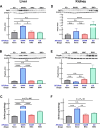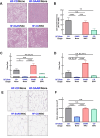Pharmacological recapitulation of the lean phenotype induced by the lifespan-extending sulfur amino acid-restricted diet
- PMID: 40202448
- PMCID: PMC12074818
- DOI: 10.18632/aging.206237
Pharmacological recapitulation of the lean phenotype induced by the lifespan-extending sulfur amino acid-restricted diet
Abstract
Sulfur amino acid restriction (SAAR), lowering the dietary concentration of sulfur amino acids methionine and cysteine, induces strong anti-obesity effects in rodents. Due to difficulties in formulating the SAAR diet for human consumption, its translation is challenging. Since our previous studies suggest a mechanistic role for low glutathione (GSH) in SAAR-induced anti-obesity effects, we investigated if the pharmacological lowering of GSH recapitulates the lean phenotype in mice on a sulfur amino acid-replete diet. Male obese C57BL6/NTac mice were fed high-fat diets with 0.86% methionine (CD), 0.12% methionine (SAAR), SAAR diet supplemented with a GSH biosynthetic precursor, N-acetylcysteine in water (NAC), and CD supplemented with a GSH biosynthetic inhibitor, DL-buthionine-(S, R)-sulfoximine in water (BSO). The SAAR diet lowered hepatic GSH but increased Nrf2, Phgdh, and serine. These molecular changes culminated in lower hepatic lipid droplet frequency, epididymal fat depot weights, and body fat mass; NAC reversed all these changes. BSO mice exhibited all SAAR-induced changes, with two notable differences, i.e., a smaller effect size than that of the SAAR diet and a higher predilection for molecular changes in kidneys than in the liver. Metabolomics data indicate that BSO and the SAAR diet induce similar changes in the kidney. Unaltered plasma aspartate and alanine transaminases and cystatin-C indicate that long-term continuous administration of BSO is safe. Data demonstrate that BSO recapitulates the SAAR-induced anti-obesity effects and that GSH plays a mechanistic role. BSO dose-response studies in animals and pilot studies in humans to combat obesity are highly warranted.
Keywords: aging; anti-obesity drugs; buthionine sulfoximine; serine; thiols.
Conflict of interest statement
Figures







References
-
- Plaisance EP, Greenway FL, Boudreau A, Hill KL, Johnson WD, Krajcik RA, Perrone CE, Orentreich N, Cefalu WT, Gettys TW. Dietary methionine restriction increases fat oxidation in obese adults with metabolic syndrome. J Clin Endocrinol Metab. 2011; 96:E836–40. 10.1210/jc.2010-2493 - DOI - PMC - PubMed
MeSH terms
Substances
LinkOut - more resources
Full Text Sources
Miscellaneous

